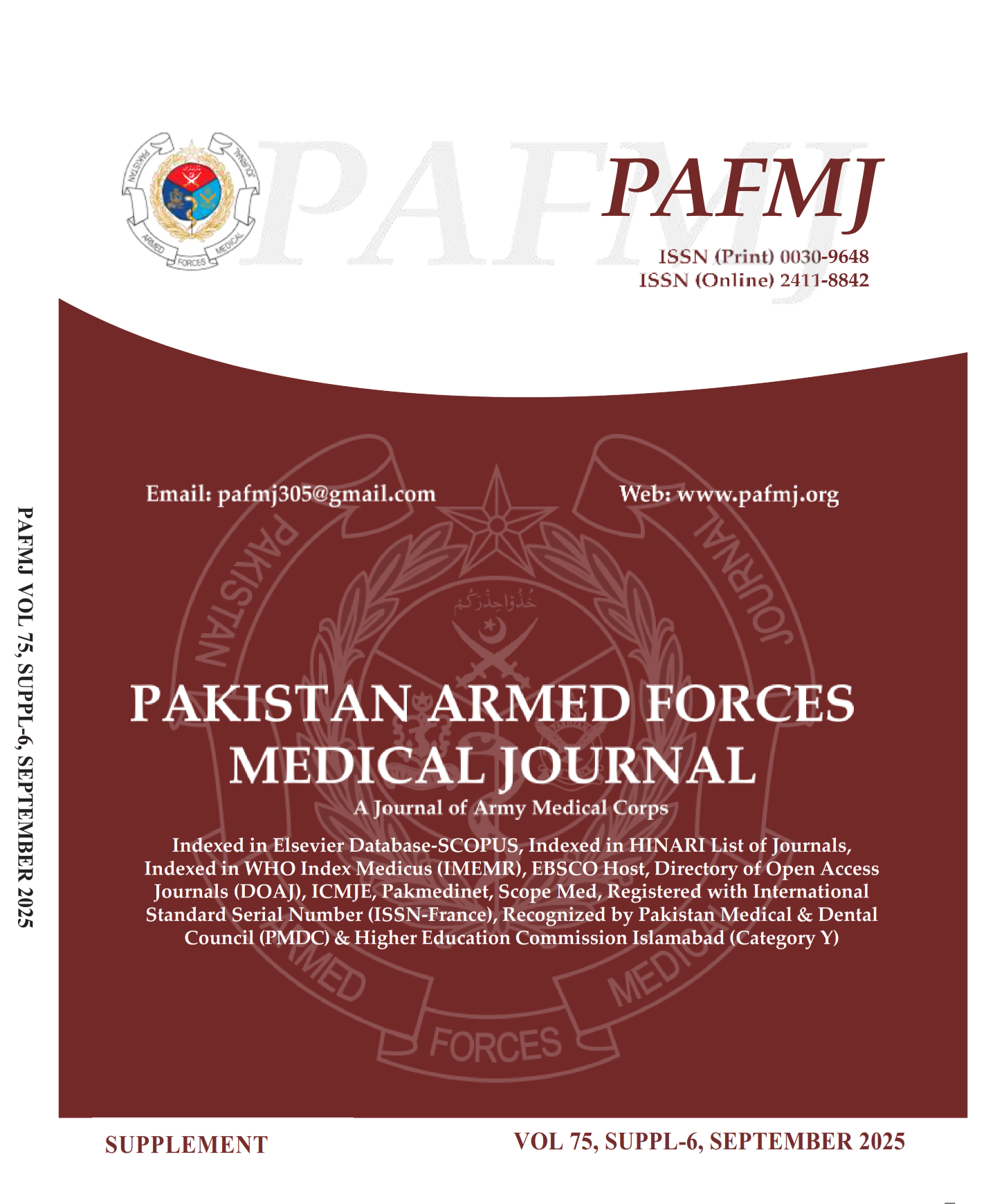Association of Biochemical Markers with Presence of Retinopathy Among Patients Managed with Type-II Diabetes
DOI:
https://doi.org/10.51253/pafmj.v75iSUPPL-6.9018Keywords:
Diabetic retinopathy; Microalbuminuria; Type II DM; uric acidAbstract
Objective: To look for association of uric acid levels, erythrocyte sedimentation rate, LDL-cholesterol and microalbuminuria with presence of retinopathy among patients managed with Type-II Diabetes
Study Design: Comparative cross-sectional study
Place and Duration of Study: Department of Medicine, Combined Military Hospital Skardu from November 2021 to June 2022
Subjects and Methods: The sample population comprised of 120 type II diabetes patients managed either with oral hypoglycemic agents or insulin. Diabetic retinopathy was diagnosed by consultant ophthalmologist of our own hospital. Patients underwent all baseline investigations including biochemical markers included in the study. Association of uric acid levels, erythrocyte sedimentation rate, LDL-cholesterol and microalbuminuria was established with presence of diabetic retinopathy among the study participants.
Results: Out of 120 patients of type-II diabetes mellitus included in the study, 76(63.3%) were male while 44(36.7%) were female. Mean age of the patients was 44.59±6.175 years. Mean duration of type-II Diabetes Mellitus in the study participants was 4.23±4.56 years. Out of 120 patients, 75(62.5%) patients had no diabetic retinopathy while 45(37.5%) patients had retinopathy. Statistical analysis revealed that hyperuricemia and microalbuminuria had statistically significant association with presence of diabetic retinopathy in study participants (p-value<0.05).
Conclusion: Considerable number of patients with type-II diabetes mellitus had diabetic retinopathy in our data set. Patients with raised serum uric acid levels and presence of microalbuminuria were found more at risk of having diabetic retinopathy as compared to those patients who did not have these biochemical abnormalities.
Downloads
References
1. Uloko AE, Musa BM, Ramalan MA, et al. Prevalence and Risk Factors for Diabetes Mellitus in Nigeria: A Systematic Review and Meta-Analysis. Diabetes Ther. 2018; 9(3): 1307-1316.
2. Bullard KM, Cowie CC, Lessem SE, et al. Prevalence of Diagnosed Diabetes in Adults by Diabetes Type - United States, 2016.MMWR Morb Mortal Wkly Rep. 2018; 67(12): 359-361.
https://doi:10.15585/mmwr.mm6712a2
3. Al Mansari A, Obeid Y, Islam N, et al. GOAL study: clinical and non-clinical predictive factors for achieving glycemic control in people with type 2 diabetes in real clinical practice. BMJ Open Diabetes Res Care. 2018; 6(1): e000519.
https://doi:10.1136/bmjdrc-2018-000519
4. Sherwani SI, Khan HA, Ekhzaimy A, Masood A, Sakharkar MK. Significance of HbA1c Test in Diagnosis and Prognosis of Diabetic Patients. Biomark Insights. 2016; 11: 95-104.
https://doi:10.4137/BMI.S38440
5. Widyaputri F, Rogers SL, Kandasamy R, Shub A, Symons RCA, Lim LL. Global Estimates of Diabetic Retinopathy Prevalence and Progression in Pregnant Women With Preexisting Diabetes: A Systematic Review and Meta-analysis. JAMA Ophthalmol. 2022; 140(5): 486-494.
https://doi:10.1001/jamaophthalmol.2022.0050
6. Chung, Yu-Chien et al. “Early Screening for Diabetic Retinopathy in Newly Diagnosed Type 2 Diabetes and Its Effectiveness in Terms of Morbidity and Clinical Treatment: A Nationwide Population-Based Cohort.” Frontiers in public health vol. 10 771862. 26 Apr. 2022,
https://doi:10.3389/fpubh.2022.771862
7. Guo Y, Liu S, Xu H. Uric Acid and Diabetic Retinopathy: A Systematic Review and Meta-Analysis. Front Public Health. 2022; 10(3): 906760.
https://doi:10.3389/fpubh.2022.906760
8. Rathsman B, Haas J, Persson M, et al. LDL cholesterol level as a risk factor for retinopathy and nephropathy in children and adults with type 1 diabetes mellitus: A nationwide cohort study. J Intern Med. 2021; 289(6): 873-886.
https://doi:10.1111/joim.13212
9. Dash S, Chougule A, Mohanty S. Correlation of Albuminuria and Diabetic Retinopathy in Type-II Diabetes Mellitus Patients. Cureus. 2022; 14(2): e21927.https://doi:10.7759/cureus.21927
10. Mumtaz SN, Fahim MF, Arslan M, Shaikh SA, Kazi U, Memon MS. Prevalence of diabetic retinopathy in Pakistan; A systematic review. Pak J Med Sci. 2018; 34(2): 493-500.
https://doi:10.12669/pjms.342.13819
11. Hashemi H, Rezvan F, Pakzad R, Ansaripour A, Heydarian S, Yektaet al A. Global and Regional Prevalence of Diabetic Retinopathy; A Comprehensive Systematic Review and Meta-analysis. Semin Ophthalmol. 2022; 37(3): 291-306.
https://doi:10.1080/08820538.2021.1962920
12. Pearce E, Sivaprasad S. A Review of Advancements and Evidence Gaps in Diabetic Retinopathy Screening Models. Clin Ophthalmol. 2020; 14(3): 3285-3296.
https://doi:10.2147/OPTH.S267521
13. Desideri G, Castaldo G, Lombardi A, Mussap M, Testa A, Pontremoliet R al. Is it time to revise the normal range of serum uric acid levels?. Eur Rev Med Pharmacol Sci. 2014; 18(9): 1295-1306.
14. Moidu S, Oomen AT, Pillai G, Vs S. Microalbuminuria as an Independent Risk Factor for Developing Concentric Left Ventricular Hypertrophy in Primary Hypertension: A Single-Center Observational Study From South India. Cureus. 2022; 14(1): e21119. https://doi:10.7759/cureus.21119
15. Ahn JH, Ahn Y, Jeong MH, et al. Optimal low-density lipoprotein cholesterol target level in Korean acute myocardial infarction patients (<70 mg/dL vs. <55 mg/dL): Based on Korea acute myocardial infarction registry-National Institute of Health. Int J Cardiol. 2022; 351(3): 15-22. https://doi:10.1016/j.ijcard.2021.12.020
16. Asawapattanakul T, Pintapagung T, Piratae S, Juntautsa S, Chancharoen P. Erythrocyte sedimentation rate, C-reactive protein, and interleukin-6 as inflammatory biomarkers in dogs naturally infected with Ehrlichia canis. Vet World. 2021; 14(9): 2325-2331. https://doi:10.14202/vetworld.2021.2325-2331
17. Chawla S, Trehan S, Chawla A, et al. Relationship between diabetic retinopathy microalbuminuria and other modifiable risk factors. Prim Care Diabetes. 2021;15(3):567-570.
https://doi:10.1016/j.pcd.2021.01.012
18. Xiong Q, Liu J, Xu Y. Effects of Uric Acid on Diabetes Mellitus and Its Chronic Complications. Int J Endocrinol. 2019; 2019(1): 9691345. https://doi:10.1155/2019/9691345
19. Liu Z, Shao M, Ren J, Qiu Y, Li S, Cao W. Association Between Increased Lipid Profiles and Risk of Diabetic Retinopathy in a Population-Based Case-Control Study. J Inflamm Res. 2022; 15(2): 3433-3446.https://doi:10.2147/JIR.S361613
20. Hu Y, Li Q, Min R, Deng Y, Xu Y, Gao L. The association between serum uric acid and diabetic complications in patients with type 2 diabetes mellitus by gender: a cross-sectional study. PeerJ. 2021; 9(1): e10691. https://doi:10.7717/peerj.10691
Downloads
Published
Issue
Section
License
Copyright (c) 2025 Syed Ali Ghawas, Muhammad Faheem, Anam Manzoor Alam, Ahsan Mehmood, Muhammad Adil, Mustajab Alam

This work is licensed under a Creative Commons Attribution-NonCommercial 4.0 International License.















